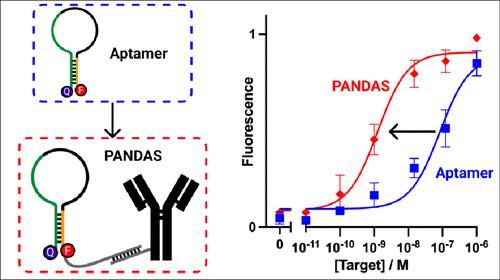Our official English website, www.x-mol.net, welcomes your feedback! (Note: you will need to create a separate account there.)
Aptamer–Antibody Chimera Sensors for Sensitive, Rapid, and Reversible Molecular Detection in Complex Samples
ACS Sensors ( IF 8.9 ) Pub Date : 2024-02-26 , DOI: 10.1021/acssensors.3c01638 Dehui Kong 1 , Ian A. P. Thompson 2 , Nicolo Maganzini 2 , Michael Eisenstein 1, 2 , Hyongsok Tom Soh 1, 2
ACS Sensors ( IF 8.9 ) Pub Date : 2024-02-26 , DOI: 10.1021/acssensors.3c01638 Dehui Kong 1 , Ian A. P. Thompson 2 , Nicolo Maganzini 2 , Michael Eisenstein 1, 2 , Hyongsok Tom Soh 1, 2
Affiliation

|
The development of receptors suitable for the continuous detection of analytes in complex, interferent-rich samples remains challenging. Antibodies are highly sensitive but difficult to engineer in order to introduce signaling functionality, while aptamer switches are easy to construct but often yield only a modest target sensitivity. We present here a programmable antibody and DNA aptamer switch (PANDAS), which combines the desirable properties of both receptors by using a nucleic acid tether to link an analyte-specific antibody to an internal strand-displacement (ISD)-based aptamer switch that recognizes the same target through different epitopes. The antibody increases PANDAS analyte binding due to its high affinity, and the effective concentration between the two receptors further enhances two-epitope binding and fluorescent aptamer signaling. We developed a PANDAS sensor for the clotting protein thrombin and show that a tuned design achieves a greater than 300-fold enhanced sensitivity compared to that of using an aptamer alone. This design also exhibits reversible binding, enabling repeated measurements with a temporal resolution of ∼10 min, and retains excellent sensitivity even in interferent-rich samples. With future development, this PANDAS approach could enable the adaptation of existing protein-binding aptamers with modest affinity to sensors that deliver excellent sensitivity and minute-scale resolution in minimally prepared biological specimens.
中文翻译:

用于复杂样品中灵敏、快速和可逆分子检测的适体-抗体嵌合传感器
开发适合连续检测复杂、富含干扰物的样品中分析物的受体仍然具有挑战性。抗体高度敏感,但难以设计以引入信号传导功能,而适体开关易于构建,但通常只能产生适度的目标灵敏度。我们在这里提出了一种可编程抗体和 DNA 适体开关 (PANDAS),它通过使用核酸系绳将分析物特异性抗体连接到基于内部链置换 (ISD) 的适体开关来结合两种受体的所需特性。通过不同的表位实现相同的目标。该抗体由于其高亲和力而增加了 PANDAS 分析物的结合,并且两个受体之间的有效浓度进一步增强了两个表位结合和荧光适体信号传导。我们开发了一种用于凝血蛋白凝血酶的 PANDAS 传感器,并表明与单独使用适体相比,经过调整的设计可将灵敏度提高 300 倍以上。该设计还表现出可逆结合,能够以约 10 分钟的时间分辨率进行重复测量,即使在富含干扰物的样品中也能保持出色的灵敏度。随着未来的发展,这种 PANDAS 方法可以使现有的蛋白质结合适体与传感器具有适度的亲和力,从而在最少准备的生物样本中提供出色的灵敏度和分钟级分辨率。
更新日期:2024-02-26
中文翻译:

用于复杂样品中灵敏、快速和可逆分子检测的适体-抗体嵌合传感器
开发适合连续检测复杂、富含干扰物的样品中分析物的受体仍然具有挑战性。抗体高度敏感,但难以设计以引入信号传导功能,而适体开关易于构建,但通常只能产生适度的目标灵敏度。我们在这里提出了一种可编程抗体和 DNA 适体开关 (PANDAS),它通过使用核酸系绳将分析物特异性抗体连接到基于内部链置换 (ISD) 的适体开关来结合两种受体的所需特性。通过不同的表位实现相同的目标。该抗体由于其高亲和力而增加了 PANDAS 分析物的结合,并且两个受体之间的有效浓度进一步增强了两个表位结合和荧光适体信号传导。我们开发了一种用于凝血蛋白凝血酶的 PANDAS 传感器,并表明与单独使用适体相比,经过调整的设计可将灵敏度提高 300 倍以上。该设计还表现出可逆结合,能够以约 10 分钟的时间分辨率进行重复测量,即使在富含干扰物的样品中也能保持出色的灵敏度。随着未来的发展,这种 PANDAS 方法可以使现有的蛋白质结合适体与传感器具有适度的亲和力,从而在最少准备的生物样本中提供出色的灵敏度和分钟级分辨率。



























 京公网安备 11010802027423号
京公网安备 11010802027423号